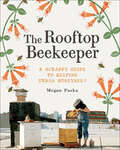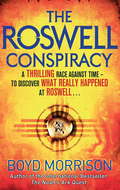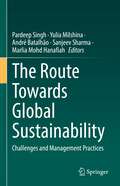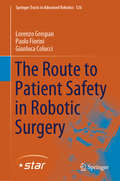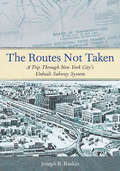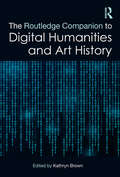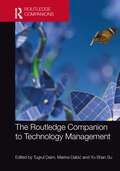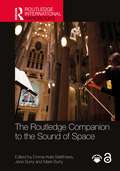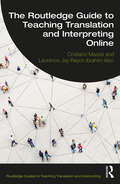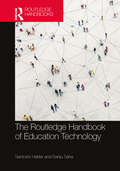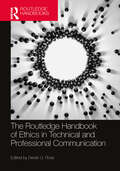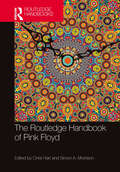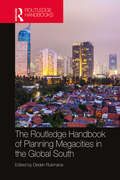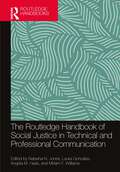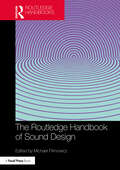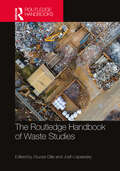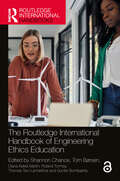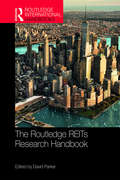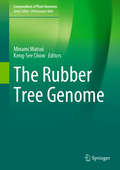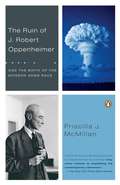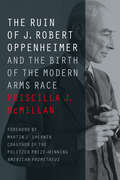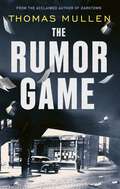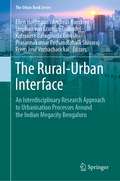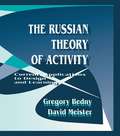- Table View
- List View
The Rooftop Beekeeper: A Scrappy Guide to Keeping Urban Honeybees
by Megan PaskaJoin the growing number of urban beekeepers with this comprehensive guide—featuring photos, honey recipes, and more—by Brooklyn’s go-to apiarist. Despite living in the most populous borough in New York City, Megan Paska has established herself as a sought-after, professional beekeeper. In The Rooftop Beekeeper, she shares essential advice, plus tips on how to get the most out of your honeybees. Paska shares her own personal experiences while offering practical checklists, numbered how-tos, beautiful illustrations, and seventy-five color photographs. Covering all aspects of urban beekeeping, this book also provides readers with plenty of sweet recipes for delicious treats, tonics, and beauty products to make with home-harvested honey.
The Roswell Conspiracy
by Boyd Morrison1947Ten-year-old Fay Allen of Roswell, New Mexico, witnesses the fiery crash of an extraordinary craft unlike anything she's ever seen...2012More than sixty years later, army engineer Tyler Locke rescues Fay from a pair of assassins. She says they were after a piece of wreckage she obtained from the Roswell crash - and she claims to know secrets about that incident that have never previously been revealed.Tyler is initially sceptical, but after he is kidnapped by a mysterious band of mercenaries, he comes to believe that Roswell holds the key to his and his countrymen's survival. And he realises that there is a desperate race against time for him to uncover its secrets...Fast-paced and thrilling, The Roswell Conspiracy draws on actual details from the Roswell Incident to create a page-turning and thought-provoking thriller.
The Route Towards Global Sustainability: Challenges and Management Practices
by Sanjeev Sharma Pardeep Singh Yulia Milshina Marlia Mohd Hanafiah André BatalhãoThis volume discusses topics of global sustainability involving sustainability indicators, stakeholders' participation, and technological and strategic advances with the goal of "thinking locally to act globally". Scientists, academics, policymakers, and planners are currently focused on escalating global socioeconomic and ecological issues, such as rising inequality, adverse anthropogenic impacts on the environment, and deficiencies in natural resources. These variables are pushing the earth system's resistance capacity past its breaking point, with additional pressures incurred by a global pandemic. Therefore, this book looks to impart knowledge on participatory learning action research for human and environmental health and well-being. Sustainable development planning and management are needed in these pressing circumstances, and they necessitate an analytical interpretation of ongoing processes, current and future challenges, and an understanding of available tools and technologies. The main sections of the book focus on challenges and management practices for global sustainability, promoting educational values, smart initiatives in urban contexts, and integrating emerging sustainability dimensions in policies and legislation. The primary audience for the work is policy makers, urban planners, social scientists, economists, NGOs, and students, researchers, and educators engaged in environmental social science and sustainability management.
The Route to Patient Safety in Robotic Surgery (Springer Proceedings in Advanced Robotics #126)
by Lorenzo Grespan Paolo Fiorini Gianluca ColucciThe introduction of a new technology in a consolidated field has the potential to disrupt usual practices and create a fertile ground for errors. An example is robotic surgery that is now used in most surgical specialties, pushed by technology developers and enthusiastic surgeons. To analyze the potential impact of robotic surgery on patient safety, a consortium of major European Universities started the project SAFROS whose findings are summarized and further elaborated in the three parts of this book. Part one describes safety in complex systems such as surgery, how this may disrupt the traditional surgical workflow, how safety can be monitored, and the research questions that must be posed. Part two of the book describes the main findings of this research, by identifying the risks of robotic surgery and by describing where its ancillary technologies may fail. This part addresses features and evaluation of anatomic imaging and modeling, actions in the operating room, robot monitoring and control, operator interface, and surgical training. Part three of the book draws the conclusions and offers suggestions on how to limit the risks of medical errors. One possible approach is to use automation to monitor and execute parts of an intervention, thus suggesting that robotics and artificial intelligence will be major elements of the operating room of the future.
The Routes Not Taken: A Trip Through New York City's Unbuilt Subway System
by Joseph B. RaskinA fascinating journey into the past—and under the ground—that offers &“an insightful look at the what-might-have-beens of urban mass transit&” (The New York Times). From the day it broke ground by City Hall in 1900, it took about four and half years to build New York&’s first subway line to West 145th Street in Harlem. Things rarely went that quickly ever again. The Routes Not Taken explores the often-dramatic stories behind unbuilt or unfinished subway lines. The city&’s efforts to expand its underground labyrinth were often met with unexpected obstacles—financial shortfalls, clashing political agendas, battles with community groups, and more. After discovering a copy of the 1929 subway expansion map, Joseph B. Raskin began his own investigation into the city&’s underbelly. Here he provides an extensively researched history of the Big Apple&’s unfinished business. The Routes Not Taken sheds light on: *the efforts to expand the Hudson Tubes into a full-fledged subway *the Flushing line, and why it never made it past Flushing *a platform under Brooklyn&’s Nevins Street station unused for more than a century *the 2nd Avenue line—long the symbol of dashed dreams—deferred countless times since the original plans were presented in 1929 Raskin reveals the personalities involved, explaining why Fiorello H. La Guardia couldn&’t grasp the importance of subway lines and why Robert Moses found them old and boring. By focusing on unbuilt lines, he illustrates how the existing system is actually a Herculean feat of countless compromises. Filled with illustrations, this is an enduring contribution to the history of transportation and the history of New York City.
The Routledge Companion to Digital Humanities and Art History (Routledge Art History and Visual Studies Companions)
by Kathryn BrownThe Routledge Companion to Digital Humanities and Art History offers a broad survey of cutting-edge intersections between digital technologies and the study of art history, museum practices, and cultural heritage. The volume focuses not only on new computational tools that have been developed for the study of artworks and their histories but also debates the disciplinary opportunities and challenges that have emerged in response to the use of digital resources and methodologies. Chapters cover a wide range of technical and conceptual themes that define the current state of the field and outline strategies for future development. This book offers a timely perspective on trans-disciplinary developments that are reshaping art historical research, conservation, and teaching. This book will be of interest to scholars in art history, historical theory, method and historiography, and research methods in education.
The Routledge Companion to Technology Management (Routledge Companions in Business, Management and Marketing)
by Tugrul Daim Marina Dabić Yu-Shan SuBringing together an international range of expertise, this comprehensive Companion to Technology Management is designed to facilitate the development of management frameworks adaptable for a wide range of organizations, as well as an overview of the development and integration of technology in advanced and emerging economies. Research-based and drawing on a range of practical tools and international cases, it covers the diverse spectrum of the challenges of technology management and how to approach them: I Fundamentals of Technology Management provides an overview of the fundamental aspects of technology management. II Technology Planning focusses on technology-driven organizations, government labs and universities. III Technology Evaluation includes evaluation and assessment, adoption and forecasting through management tools. IV Technology Development and Transfer includes integration, marketing and intellectual property management. V Managing Technological Innovations addresses policy, open innovation and technology entrepreneurship. VI Society and Technology Management focusses on social issues which impact technology and its management. VII New Technologies and Emerging Regions includes blockchain, biotechnologies and smart cities. This Companion is an essential comprehensive source of new and emerging approaches for researchers and advanced students in engineering and technology management, as well as professionals seeking an authoritative global reference source.
The Routledge Companion to the Sound of Space (Routledge International Handbooks)
by Mark Taylor Raj Patel Jeff Malpas Paul Carter Mark Burry Lawrence Harvey Jane Burry Philip Coleman David Buck David Toop Jordan Lacey Wes McGee Gascia Ouzounian Emma Margetson Emma-Kate Matthews Pantea Alambeigi Sven Anderson Paul Bavister Zackery Belanger John Levack Drever Sasha Elina Stuart Favilla’s Iain Forsyth & Jane Pollard Michael Fowler Raviv Ganchrow Nina Garthwaite Philip Jackson Ildar Khannanov Emil Kraugerud Fabricio Mattos Angela McArthur Ben McDonnell Carla Molinari Shane Myrbeck Catie Newell Pedro Novo Eleni-Ira Panourgia Rosalind Parker Philip Samartzis Gerriet K. Sharma Jonathan Tyrrell Gerrie Van Noord Cobi Van Tonder Jan St. Werner Sipei ZhaoThis companion explores a range of conceptual and practical relationships between sound and space across various disciplines, providing insights from technical, creative, cultural, political, philosophical, psychological, and physiological perspectives. The content spans a wide range of spatial typologies, from large reverberant buildings to modest and intimate ones, from external public squares to domestic interiors, and from naturally formed environments to highly engineered spaces. These compiled insights and observations explore the vast diversity of ways in which sonic and spatial realms interact.This publication therefore forms important bridges between the intricate and diverse topics of technology, philosophy, composition, performance, and spatial design, to contemplate the potential of sound and space as tools for creative expression and communication, as well as for technical innovation. It is hoped that by sharing these insights, this book will inspire practitioners, scholars, and enthusiasts to incorporate new perspectives and methodologies into their own work.Through a rich blend of theory, practice, and critical reflection, this volume serves as a valuable resource for anyone interested in exploring the intricacy of relationships between space and sound, whether they are students, professionals, or simply curious. Our companion provides a cross-section through shared territories between sonic and spatial disciplines from architecture, engineering, sound design, music composition and performance, urban design, product design, and much more.
The Routledge Guide to Teaching Translation and Interpreting Online (Routledge Guides to Teaching Translation and Interpreting)
by Cristiano Mazzei Laurence Jay-Rayon Ibrahim AiboRoutledge Guides to Teaching Translation and Interpreting is a series of practical guides to key areas of translation and interpreting for instructors, lecturers, and course designers. The Routledge Guide to Teaching Translation and Interpreting Online is for educators of translation and interpreting teaching online in a variety of curricular combinations: fully online, partially online, hybrid, multimodal, or face-to-face with online components. Offering suggestions for the development of curriculum and course design in addition to online tools that can be used in skill-building activities, and adaptable to specific instructional needs, this textbook is suitable for both multilingual and language-specific classes. Fully comprehensive, the book addresses the tenets and importance of process-oriented pedagogy for students of translation and interpreting, best practices in online curriculum and course design, instructor online presence, detailed illustrations of specific online assignments, the importance of regular and timely feedback, and teaching across the online translation and interpreting (T&I) curriculum. Written by two experienced translators, interpreters, and scholars who have been teaching online for many years and in various settings, this book is an essential guide for all instructors of translation and interpreting as professional activities and academic disciplines.
The Routledge Handbook of Education Technology
by Santoshi Halder Sanju SahaThis handbook offers a comprehensive understanding of the use of technology in education. With a focus on the development of Education Technology in India, it explores innovative strategies as well as challenges in incorporating technology to support learning. The volume examines diverse learning approaches such as assistive technology and augmentative and alternative communication for learners with disabilities and creating more social and accessible environments for learning through Collaborative Learning Techniques (CoLTS), massive open online courses (MOOCs), and the use of AI (Artificial Intelligence) in modern classrooms. Enriched with discussions on recent trends in ET (Education Technology), university curriculum and syllabi, and real-life examples of the use of ET in different classroom settings, the book captures diverse aspects of education technology and its potential. It also discusses the challenges of making technology and resources available for all and highlights the impact technology has had in classrooms across the world during the COVID-19 pandemic. This book will be of interest to students, researchers, and teachers of education, digital education, education technology, and information technology. The book will also be useful for policymakers, educationalists, instructional designers, and educational institutions.
The Routledge Handbook of Ethics in Technical and Professional Communication (Routledge Handbooks in Communication Studies)
by Derek G. RossFeaturing specially commissioned chapters from scholars and practitioners across the field, this handbook serves as a touchstone for those who wish to do ethical technical and professional communication in its myriad forms.Offering an overview of what “ethics” in technical and professional communication looks like, what “being ethical” entails, and what it means to “do ethical work,” this handbook is divided into five interrelated parts and an Afterword: Why Ethics? Foundations: What Are Ethics, and How Do They Fit into Technical and Professional Communication? Local Application: What Does “Being Ethical” Mean to the Individual? Institutional Application: What Does “Being Ethical” Mean at the Institutional Level? The Future of Ethics in Technical Communication: What Happens Next? The first of its kind, this accessibly written handbook explores descriptive, normative, applied, and meta-ethics. It will be an indispensable resource for researchers and students in the fields of Technical and Professional Communication, Writing Studies, Rhetoric, and Design.
The Routledge Handbook of Pink Floyd (Routledge Music Handbooks)
by Chris Hart Simon A. MorrisonThe Routledge Handbook of Pink Floyd is intended for scholars and researchers of popular music, as well as music industry professionals and fans of the band. It brings together international researchers to assess, evaluate and reformulate approaches to the critical study and interpretation of one of the world’s most important and successful bands. For the first time, this Handbook will ‘tear down the wall,’ examining the band’s collective artistic creations and the influence of social, technological, commercial and political environments over several decades on their work. Divided into five parts, the book provides a thoroughly contextualised overview of the musical works of Pink Floyd, including coverage of performance and sound; media, reception and fandom; genre; periods of Pink Floyd’s work; and aesthetics and subjectivity. Drawing on art, design, performance, culture and counterculture, emergent theoretical resources and analytical frames are evaluated and discussed from across the social sciences, humanities and creative arts. The Handbook is intended for scholars and researchers of popular music, as well as music industry professionals. It will appeal across a range of related subjects from music production to cultural studies and media/communication studies.
The Routledge Handbook of Planning Megacities in the Global South
by Deden RukmanaCities are now home to 55% of the world’s population, and that number is rising. Urban populations across the world will continue to grow, including in megacities with populations over ten million. In 2016 there were 31 megacities globally, according to the United Nations’ World Cities Report, with 24 of those cities located in the Global South. That number is expected to rise to 41 by 2030, with all ten new megacities in the Global South where the processes of urbanization are intrinsically distinct from those in the Global North. The Routledge Handbook of Planning Megacities in the Global South provides rigorous comparative analyses, discussing the challenges, processes, best practices, and initiatives of urbanization in Middle America, South America, the Middle East, Africa, South Asia, East Asia, and Southeast Asia. This book is indispensable reading for students and scholars of urban planning, and its significance as a resource will only continue to grow as urbanization reshapes the global population.
The Routledge Handbook of Social Justice in Technical and Professional Communication (Routledge Handbooks in Communication Studies)
by Laura Gonzales Miriam F. Williams Natasha N. Jones Angela M. HaasThis handbook interrogates and illustrates contemporary approaches to technical and professional communication (TPC) by focusing on emerging issues in the field. Using a social justice-centered approach, the handbook provides a view of the current state of the discipline and highlights emerging directions and perspectives that will influence the trajectory of the field in the coming years. It is divided into five interrelated parts: Disciplinarity Pedagogy Practice Social Change Intersections: Cultures and Communities Acknowledging that TPC is always embedded and participating in specific power structures, The Routledge Handbook of Social Justice in Technical and Professional Communication offers readers a way forward, a future imagined and re-imagined, and presents scholarship that is progress-in-process for TPC. Providing frameworks and strategies for embracing a social justice-driven approach, this handbook will be of interest to scholars, teachers, administrators, community leaders, and workplace and industry practitioners in the field of TPC.
The Routledge Handbook of Sound Design
by Michael FilimowiczThe Routledge Handbook of Sound Design offers a comprehensive overview of the diverse contexts of creativity and research that characterize contemporary sound design practice. Readers will find expansive coverage of sound design in relation to games, VR, globalization, performance, soundscape and feminism, amongst other fields.Half a century since its formal emergence, this book considers sound design in a plethora of practical contexts, including music, film, soundscape and sonification, as well as the emerging theoretical and analytical approaches being used in scholarship on the subject. The Routledge Handbook of Sound Design tracks how ideas and techniques have migrated from one field to the next, as professionals expand the industry applications for their skills and knowledge, and technologies produce new form factors for entertainment and information.Collectively, the chapters included in this volume illustrate the robustness and variety of contemporary sound design research and creativity, making The Routledge Handbook of Sound Design essential reading for students, teachers, researchers and practitioners working on sound design in its many forms.
The Routledge Handbook of Waste Studies (Routledge Environment and Sustainability Handbooks)
by Zsuzsa GilleThe Routledge Handbook of Waste Studies offers a comprehensive survey of the new field of waste studies, critically interrogating the cultural, social, economic and political systems within which waste is created, managed and circulated. While scholars have not settled on a definitive categorization of what waste studies is, more and more researchers claim that there is distinct cluster of inquiries, concepts, theories and key themes that constitute this field. In this handbook the editors and contributors explore the research questions, methods and case studies preoccupying academics working in this field, in an attempt to develop a set of criteria by which to define and understand waste studies as an interdisciplinary field of study. This handbook will be invaluable to those wishing to broaden their understanding of waste studies and to students and practitioners of geography, sociology, anthropology, history, environment and sustainability studies.
The Routledge International Handbook of Engineering Ethics Education (Routledge International Handbooks of Education)
by Shannon Chance and Tom BørsenResponding to the need for a timely and authoritative volume dedicated to this burgeoning and expansive area of research, this handbook will provide readers with a map of themes, topics, and arguments in the field of engineering ethics education (EEE).Featuring critical discussion, research collaboration, and a team of international contributors of globally recognized standing, this volume comprises six key sections which elaborate on the foundations of EEE, teaching methods, accreditation and assessment, and interdisciplinary contributions. Over 100 researchers of EEE from around the globe consider the field from the perspectives of teaching, research, philosophy, and administration. The chapters cover fast-moving topics central to our current understanding of the world such as the general data protection regulation (GDPR), artificial intelligence (AI), biotechnology, and ChatGPT; and they offer new insights into best practices research to equip program leaders and instructors delivering ethics content to students.This Open Access volume will be of interest to researchers, scholars, postgraduate students, and faculty involved with engineering education, engineering ethics, and philosophy of education. Curriculum designers, staff developers teaching pedagogical courses to faculty, and engineering professionals may also benefit from this volume.The Open Access version of this book, available at http://www.taylorfrancis.com, has been made available under a Creative Commons Attribution-Non Commercial-No Derivatives (CC-BY-NC-ND) 4.0 license.
The Routledge REITs Research Handbook
by David ParkerThe Routledge REITs Research Handbook presents a cutting-edge examination of the research into this key global investment vehicle. Edited by internationally respected academic and REIT expert Professor David Parker, the book will set the research agenda for years to come. The handbook is divided into two parts, the first of which provides the global context and a thematic review covering: asset allocation, performance, trading, sustainability, Islamic REITs, emerging sectors and behavioural finance. Part II presents a regional review of the issues with high level case studies from a diverse range of countries including the US, UK, Brazil, India, Australia, China, Singapore, Israel and Russia, to name just a few. This handbook redefines existing areas within the context of international REITs research, highlights emerging areas and future trends and provides postgraduates, professionals and researchers with ideas and encouragement for future research. It is essential reading for all those interested in real estate, international investment, global finance and asset management.
The Rubber Tree Genome (Compendium of Plant Genomes)
by Minami Matsui Keng-See ChowThis book presents the first comprehensive compilation of genome research on the Hevea brasiliensis rubber tree. The genomes of Hevea tree clones (cultivars) are described by three major international groups. Chapters on omics-driven investigations address a broad range of topics including genome annotation and utilisation, transcriptome and gene family analysis, genetic mapping, metabolic pathways in latex and molecular breeding. Additionally, an overview of fundamental rubber biology, especially on laticifers, provides a historical background that is relevant to rubber genome analysis. The book concludes with several perspectives on the future needs of rubber investigations and prospects of rubber genomics. Given the scope of topics, this book will appeal to researchers and university students working in genomics and biotechnology of the rubber tree, and to rubber breeders with an interest in non-conventional approaches to trait analysis, selection and breeding.
The Ruin of J. Robert Oppenheimer and the Birth of the Modern Arms Race
by Priscilla McmillanIn a groundbreaking book that recasts the history of the Cold War, bestselling author Priscilla J. McMillan exposes, for the first time, the truth behind J. Robert Oppenheimer's 1954 trial on charges of violating national security. Drawing on newly declassified papers and extensive interviews, McMillan places Oppenheimer's opposition to development of the hydrogen bomb at the heart of the story--opposition that made him the victim of government officials who, conspiring with rival scientist Edward Teller, deceived President Eisenhower and trapped the enigmatic genius who had done more than anyone to build the atomic bomb. A chilling exposé of the McCarthy-era conspiracy that helped propel the East-West arms race, this is a spellbinding work of history.
The Ruin of J. Robert Oppenheimer: And the Birth of the Modern Arms Race (Johns Hopkins Nuclear History and Contemporary Affairs)
by Priscilla J. McMillanThis groundbreaking Cold War history reveals the government conspiracy to bring down America’s most famous scientist.On April 12, 1954, the nation was astonished to learn that J. Robert Oppenheimer was facing charges of violating national security. Could the man who led the effort to build the atom bomb really be a traitor? In this riveting book, Priscilla J. McMillan draws on newly declassified U.S. government documents and materials from Russia, as well as in-depth interviews, to expose the conspiracy that destroyed the director of the Manhattan Project.This meticulous narrative recreates the fraught years from 1949 to 1955 when Oppenheimer and a group of liberal scientists tried to head off the cabal of air force officials, anti-Communist politicians, and rival scientists, who were trying to seize control of U.S. policy and build ever more deadly nuclear weapons. Retelling the story of Oppenheimer’s trial, which took place in utmost secrecy, she describes how the government made up its own rules and violated many protections of the rule of law. McMilliam also argues that the effort to discredit Oppenheimer, occurring at the height of the McCarthy era and sanctioned by a misinformed President Eisenhower, was a watershed in the Cold War, poisoning American politics for decades and creating dangers that haunt us today.
The Rules of Work: A Practical Engineering Guide to Ergonomics, Second Edition
by Dan MacLeodThe experience of the past decade since the publication of the first edition of The Rules of Work: A Practical Engineering Guide to Ergonomics proves just how central ergonomics is for effective production. Revised and updated to reflect new insights from workplace developments, the second edition continues the tradition of providing essential tool
The Rumor Game
by Thomas MullenA determined reporter and a reluctant FBI agent face off against fascist elements in this gripping historical thriller set in World War II-era Boston from the multi-award-nominated author.Reporter Anne Lemire writes the Rumor Clinic, a newspaper column that disproves the many harmful rumors floating around town, some of them spread by Axis spies and others just gossip mixed with fear and ignorance. Tired of chasing silly rumors, she wants to write about something bigger. Special Agent Devon Mulvey, one of the few Catholics at the FBI, spends his weekdays preventing industrial sabotage and his Sundays spying on clerics with suspect loyalties - and he spends his evenings wooing the many lonely women whose husbands are off at war. When Anne's story about Nazi propaganda intersects with Devon's investigation into the death of a factory worker, the two are led down a dangerous trail of espionage, organized crime, and domestic fascism - one that implicates their own tangled pasts and threatens to engulf the city in violence. With vibrant historical atmosphere and a riveting mystery that illuminates still-timely issues about disinformation and power, Thomas Mullen delivers another powerful thriller.
The Rural-Urban Interface: An Interdisciplinary Research Approach to Urbanisation Processes Around the Indian Megacity Bengaluru (The Urban Book Series)
by Stephan von Cramon-Taubadel Ellen Hoffmann Andreas Buerkert Kotrakere Basegowda Umesh Prasannakumar Pethandlahalli Shivaraj Prem José VazhacharickalBengaluru is one of the fastest growing megacities in India. As such, it provides an in-situ laboratory for studying rural-urban transitions. While urbanization is most evident in the changing landscape with increasing built-up areas, it comes along with changes in ecosystem functions, new economic opportunities, changes in social organization and individual attitudes and behavior. All of these processes are interlinked and mutually depend on each other. This book attempts to integrate studies from a wide scope of disciplinary perspectives and at different spatial scales under the framework of complex social-ecological systems.Agriculture is the prime example of a system in which humans interact with their biophysical environment, and the production systems in the rural-urban interface are profoundly affected by urbanisation. Intensification and diversification of agriculture are immediate responses to urban pressures and demands, and are linked as much to resource (over-)use as to commercialisation. Yet, little is known about the spatial patterns of agricultural transformation in areas of urban sprawl.The focus of the contributions here is explicitly on the interface, in-between the rural and urban systems. It thus differs from the urban-centered perspective of city planners as well as from the rural predominance in most of the agricultural research. In the present volume this focus is implemented by analysing samples along a spatial gradient representing different stages of urbanization. Ongoing time series analyses and a panel study will complement the spatial approach by a temporal dimension.
The Russian Theory of Activity: Current Applications To Design and Learning (Applied Psychology Series)
by David Meister Gregory BednyThe opening of the former Soviet Union to the West has provided an opportunity to describe Russian human factors/ergonomics and to compare American theories and methods with it. Although this book is principally dedicated to describing the theory of activity as it applies to issues of design and training, it is also offered to a general audience of psychologists and interested lay readers. This theory studies the goal-directed behavior of man and attempts to integrate the cognitive, motivational, and behavioral aspects of activity into a holistic system. Such fundamental notions as goal, action, and self-regulation are described and analyzed from totally different theoretical points of view. This is the first comprehensive, systematic description of the theory of activity in the English language. Existing attempts to translate the theory of activity into English suffer from certain limitations. Among them, the theory of activity -- considered one of the more important accomplishments of Soviet psychological science -- has an extensive history dating back to the work of Vygotsky and his students. Subsequent development of the theory by other well-known Soviet psychologists and psychophysiologists took place within different schools with some significant differences. In the former Soviet Union, psychological theory could not be advanced unconnected to Marxist-Leninist ideology. Accordingly, theoretical formulations were subject to their own version of "political correctness." Books published in this field were addressed only to other scientists with backgrounds in the field. Moreover, the translation of the technical terms in Russian psychology frequently resist translation in the absence of the context of the debates in which they were being used. Thus, simple translation of books in this field as they were written in a specialized and politicized environment for Russian audiences is really not a particularly sensible or worthwhile undertaking. This book is addressed in the first instance to Western psychologists. It compares, among other things, analyses of work from the former Soviet Union with the work from the West. Applications of activity theory to design and learning were paramount in the Soviet Union. Using their own theoretical perspective, the authors provide a comparative analysis of the various schools working in activity theory. They hope that this book may facilitate the exchange of ideas between Russian psychological scientists and Western psychologists working in ergonomics, human factors, industrial/organizational psychology, education, learning, and related areas where the theory of activity may find general application. This book's authors attempt to provide a contribution not only to science but also to history. Western researchers have strongly influenced Russian work, but because of negative political pressure in the former USSR, the flow of concepts was one-sided. Russian ergonomists received so much from American and Western sources that it is now important to give something back. Despite the considerable similarity between Russian and American theories and methods, the special "spin" the former put on their work may stimulate new thinking on the part of their American colleagues.
